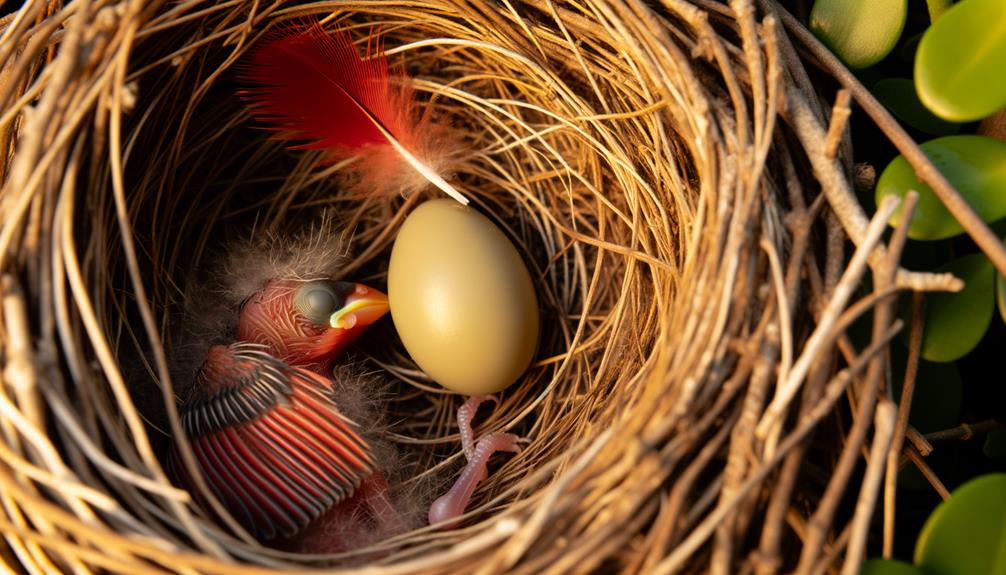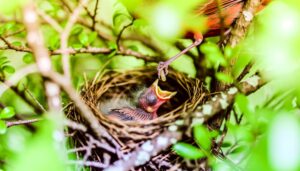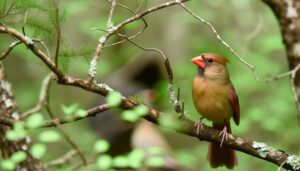Cardinal Egg Just Hatched: Why Is the Baby Now Gone?
If your newly hatched cardinal chick has disappeared, potential factors include predation, weather conditions, and human interference. Common nest predators like snakes, squirrels, and raccoons, or predatory birds, might be to blame.
Adverse weather, with cold spells or heavy rain, can also endanger young chicks. Additionally, human disturbance can prompt parents to abandon nests, putting the chick at risk.
Cardinal parents usually guard and feed their hatchlings diligently, so unusual absences often signal issues. Learning more about these aspects can shed light on what might have happened.

Key Takeaways
- Predators like snakes, squirrels, and raccoons may have taken the hatchling.
- Predatory birds such as hawks, owls, and Blue Jays pose significant risks to cardinal chicks.
- Human interference or disturbance can lead to nest abandonment by cardinal parents.
- Adverse weather conditions like cold spells and heavy rains can result in chick mortality.
- Parental negligence or failure in care can sometimes lead to the disappearance of a chick.
The Joy of Hatching
Witnessing the hatching of a cardinal egg is a mesmerizing event that showcases the intricate processes of avian development and parental care.
You'll see the chick use its egg tooth, a temporary structure, to break through the shell in a process called pipping. The chick emerges, wet and fragile, but within hours, it fluffs up and seeks warmth.
The parents immediately engage in care, feeding the hatchling a diet of insects and seeds. It's fascinating to observe how both male and female cardinals take turns bringing food and guarding the nest. This teamwork guarantees the chick's survival during its vulnerable first days.
The hatching process, though brief, is an essential and awe-inspiring phase in the life cycle of a cardinal.
Community Reactions
As the cardinal chick settles into its new life, the surrounding community of birdwatchers, neighbors, and wildlife enthusiasts enthusiastically share their observations and insights, creating a dynamic tapestry of reactions and support. Their collective excitement provides valuable data for understanding cardinal behavior and development.
Observers note key moments, such as:
- Feeding times: Documenting how often the parents feed the chick.
- Growth milestones: Tracking the chick's physical development.
- Vocalizations: Recording the types and frequencies of calls.
- Nest interactions: Noting any interactions between the chick and its parents.
These detailed observations help paint a thorough picture of the chick's early days.
Your engagement in these activities not only enhances community knowledge but also contributes to broader ornithological research.
Possible Predators
When you consider what might've happened to the baby cardinal, you should first think about common nest predators like snakes and raccoons.
Predatory bird species, such as hawks and crows, also pose significant threats. Despite the protective measures cardinals take, like nesting in dense foliage, these predators can still find and capture their young.
Common Nest Predators
Identifying common nest predators is essential for understanding the risks baby cardinals face in their early days. Observing the natural environment around cardinal nests, you'll notice several potential threats. These predators vary widely in their methods and habitats, making vigilance necessary.
Common nest predators include:
- Snakes: They can slither up trees and shrubs, preying on eggs and hatchlings.
- Squirrels: Often overlooked, these mammals can raid nests for eggs and young birds.
- Cats: Domesticated or feral, cats hunt baby birds, especially in urban or suburban areas.
- Raccoons: These nocturnal creatures are adept climbers and often target bird nests for a quick meal.
Understanding these threats allows you to better protect and preserve cardinal populations.
Predatory Bird Species
Shifting focus from ground-based threats, you should also be aware of predatory bird species that pose significant risks to baby cardinals. Birds of prey, such as hawks and owls, have keen eyesight and powerful talons, making them adept hunters. Cooper's Hawks, in particular, are known for their agility in wooded areas, often targeting smaller birds like cardinals.
Blue Jays, although not birds of prey, are notorious nest raiders and can be equally dangerous. Additionally, crows and ravens exhibit opportunistic feeding behaviors, frequently preying on nestlings. Understanding these avian predators' hunting techniques and habitats can provide valuable insights into why baby cardinals face such high predation risks and underscore the importance of their parents' vigilance.
Protective Measures Cardinals Take
To fend off potential predators, cardinals employ a variety of protective measures. They often build their nests in dense shrubs or thick foliage, providing a natural camouflage. These locations are difficult for larger predators to access. Cardinals are highly vigilant and will aggressively defend their territory.
Key protective strategies include:
- Nest placement: Building in dense, thorny vegetation.
- Vigilance: Constantly watching for threats and sounding alarm calls.
- Aggressive defense: Male cardinals will fend off intruders.
- Parental care: Both parents take turns feeding and guarding the young.
These measures enhance the survival chances of their vulnerable chicks.
Weather Factors
Adverse weather conditions, such as sudden temperature drops and heavy rainfall, can greatly impact the survival rate of newly hatched cardinal chicks.
You'll notice that these tiny, vulnerable creatures lack the ability to regulate their body temperature efficiently. Cold spells can lead to hypothermia, while heavy rains can drench their downy feathers, making it difficult for them to stay warm.
Additionally, strong winds can dislodge nests from branches, causing physical harm or exposure to predators. The combination of these factors creates a hostile environment that markedly reduces their chances of survival.
Observing these patterns reveals how essential stable weather conditions are for the early life stages of cardinals. Understanding these factors helps explain the delicate balance cardinal chicks require to thrive.
Parental Behavior
The behavior of cardinal parents is crucial in guaranteeing the survival and proper development of their newly hatched chicks. You'll notice that both the male and female cardinals play active roles in nurturing their young.
They exhibit remarkable dedication through various behaviors:
- Feeding: Parents tirelessly forage and bring back food, primarily insects, to their chicks.
- Protection: They stand guard and aggressively defend the nest from predators and intruders.
- Warmth: Cardinal parents ensure the nestlings stay warm by brooding them, especially during cooler conditions.
- Teaching: As the chicks grow, parents encourage fledging by demonstrating flying techniques and guiding them to safe perching spots.
These behaviors highlight the critical role of parental care in the early life stages of cardinals.
Human Interference
You mightn't realize that your presence near the nest can lead to dire consequences. Handling wildlife, even briefly, introduces risks such as transferring human scents or diseases.
Additionally, any noise you make can stress the parent birds, potentially causing them to abandon the nest.
Nest Disturbance Consequences
Human interference often disrupts the delicate balance of a cardinal's nest, resulting in severe consequences for the newly hatched chicks. When you approach a nest, even briefly, you can cause significant stress to the parent birds. This stress may lead to:
- Abandonment: Parents might abandon the nest entirely.
- Predation: Your presence can attract predators to the nest.
- Temperature Fluctuations: Disturbing the nest can expose chicks to harmful temperature changes.
- Feeding Interruptions: Stress can reduce the frequency of feeding visits.
Each of these outcomes can drastically lower the chicks' chances of survival. Observing from a distance with minimal interference is essential for maintaining the natural balance and ensuring the young cardinals thrive. Your actions have a significant impact on these fragile lives.
Handling Wildlife Risks
Minimizing human interference is crucial to preventing adverse impacts on wildlife, especially when dealing with vulnerable species such as newly hatched cardinals. When you approach a cardinal nest, your presence can cause significant stress to the parents and the chicks. This stress can lead to abandonment or predation.
Always observe from a distance using binoculars and never physically touch or move the nest. Your scent can attract predators like raccoons or cats. Additionally, avoid making sudden movements or loud noises that may startle the birds.
If you must intervene, contact a local wildlife rehabilitator for guidance. By reducing human contact, you help guarantee the survival and well-being of these delicate creatures in their natural habitat.
Impact of Noise
Noise pollution greatly disrupts the natural behaviors of wildlife, particularly affecting the nesting habits and stress levels of cardinals. When exposed to constant noise, cardinals may abandon their nests, leaving eggs and chicks vulnerable.
You might notice fewer cardinal sightings in noisy areas, as these birds prefer quieter habitats for breeding. Increased stress from noise can also impact their feeding patterns and overall health.
Consider the following impacts of noise pollution on cardinals:
- Abandonment of nests due to perceived threats.
- Reduced reproductive success because of disrupted mating calls.
- Increased stress hormones leading to poor health.
- Altered feeding behaviors affecting chick survival.
Conservation Efforts
Addressing the disappearance of the cardinal chick, researchers are implementing targeted conservation efforts to protect and support cardinal populations in their natural habitats.
You'll find that scientists are focusing on habitat restoration by planting native vegetation and eliminating invasive species.
They're also monitoring cardinal nests with minimal intrusion, using remote cameras to gather data on predation and environmental stresses.
Public awareness campaigns are educating people on the importance of maintaining bird-friendly environments, like reducing pesticide use and keeping domestic cats indoors.
Additionally, researchers are advocating for noise reduction in urban areas to minimize disruptions during critical breeding periods.
Conclusion
You've witnessed the delicate dance of life, where joy and sorrow often intertwine. The cardinal hatchling's sudden disappearance leaves you with unanswered questions and a heavy heart.
You ponder the myriad forces—predators, weather, even human interference—that could've played a role. In this intricate web of nature, each thread is essential yet fragile.
Conservation efforts become even more important, as every small life contributes to the grand tapestry of our ecosystem. Keep watching, keep caring; every action matters.






